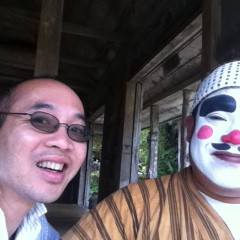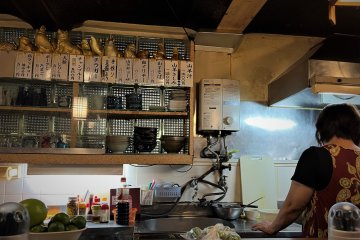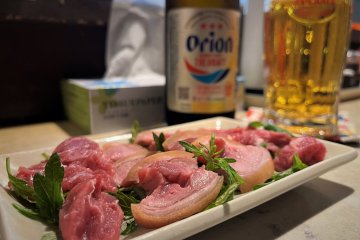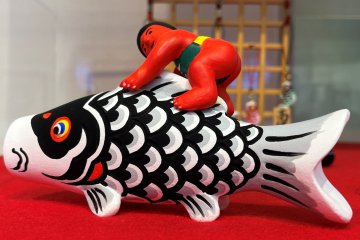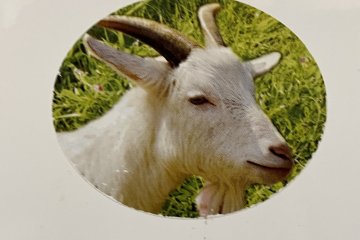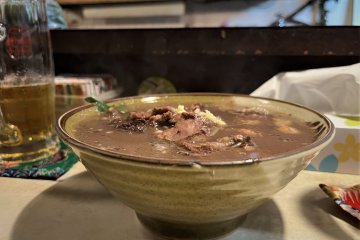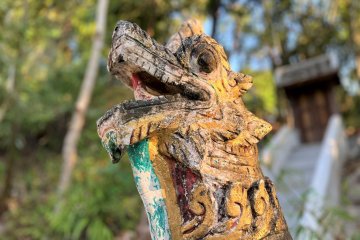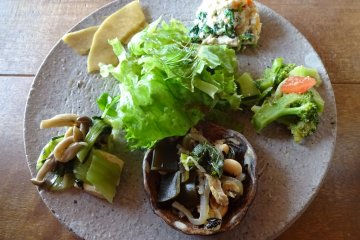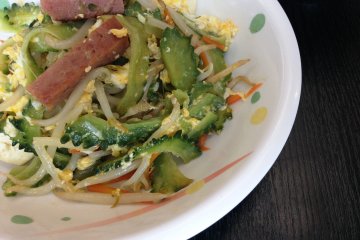In the byways that time forgot lies a goat of wisdom and determination. You may not hear its bleating, but it lives in the spirit of the 70-year-old chanteuse reliving her glory days in her impossibly short dress, her youth preserved in time in the black and white photographs. It was like she was channeling that goat like determination of Sherry Cola, who belted out her war cry, "Watch us light up the room. Passionate and powerful, yes, we are ready to bloom."
We are not in Mesopotamia or the goatskin tanneries of Fez, but the other side of the spice and silk routes, where Arabian sailors once traded the medieval equivalent of Ikea pottery, dinner plates crafted for the upwardly mobile across the sea from Naha. Inspired by the Quran which said, "it is he who appointed the stars to you, that you might guide yourselves by them through the darkness of land and sea." For almost 700 years, this hazardous but very profitable trade between the Arabs and Tang dynasty was the precursor to the trades in goods and ideas, whose hub was Naha and its spokes extended to Fuzhou, Java and Siam. Who said the ancestors of these Okinawan dancers can’t learn fast?
The ode to the 70-year-old is not far-fetched, as the only other patrons in this dated eatery, whose décor resembles some relic from the 1960s, are silver haired Okinawans. Just don't write them off, for they are fitter, healthier, and more alert than most of us mere mortals, us who only live to 80, while these aspiring centenarians can transform themselves as a nimble dancer in a heartbeat. All it needs is for someone play a folk song on the sanshin, and the place spontaneously combusts into an all dancing all singing festival, with these previously sedate leprechauns balancing heavy bowls on their head while they let their fingers and hips do the talking.
Anthropology of goat cuisine
Goat meat, like Chui jhal, Boodog or Kaldereta, is usually associated with Bengal, Mongolian or Filipino cuisine. It is not what you normally associate with Japanese cuisine, so how did it make as a powerhouse dish in this oversized counter bar and dining room they call Misaki?
In the medieval times the Ryukyu Islands rode the wave of maritime trade, its sailors bringing back Hindu-Buddhist and Islamic folklore and culinary traditions from China, Malaya, Siam, Luzon and beyond, so it is not a stretch to see goat cuisine introduced to Okinawa, its hardy nature adapting to the land constrained archipelago. On the Malay coast closest to Okinawa, the villagers crafted sculptures of Makara, a mythical creature with features of a crocodile, fish, goat, and elephant, with possibly magical if not medicinal qualities. The Makara is the vehicle of the Hindu River goddess Ganga, a water spirit that channels fertility, traversing the oceans to the islands of the Far East. What is interesting is that the Makara, like Buddhism has made its way from India to Japan on the silk route, both on the land and maritime routes. This idea of blending aspects of different animals in a single creature survives in the form of the Merlion in Singapore and the Shisa or lion dog in Okinawa.

If you go further back, goats featured in Mesopotamia. A girl tripped over a goat, long dead and dry as a bone in the desert, and the guts inside vibrated in the hollow stomach, making a vibration sound through the goat skin, and inspiring her to create a musical instrument. Today, goat skin is still used for musical instruments in the Middle East, while python skin are imported to make the Sanshin in Okinawa.
Why would you come here
You are what you eat. A goat. An eel. These animals represent stamina and determination, qualities that can transform us, if only we can partake their very essence. Traditionally eaten in summer, the goat is said to help in enduring the intense heat, a bit like Unagi or Eel in Nagoya.
If you are a food anthropologist, or just someone looking for something off the beaten track, like the tender succulent bite of raw goat or yagi sashimi, this authentic non nonsense eatery is just the right place, a far cry from the crisp tablecloth fine dining restaurants like Kanro at Hyakuna Garan Resort.

According to Government officials, the custom of eating goat meat started in the Fifteenth Century, eventually goat broth became a treat at festivals. These days, it can be terribly hard to find young Japanese who eats goat, so much so university researchers are trying to dissect all the reasons why they are not eating it, in an attempt to get the next generation to eat it. So you are, by being here, passing this tradition to future generations.
Why you would not come here
It can be hard to stomach the thought of putting goat meat in your mouth, without thinking about the all the social and historical baggage about goats entering my mind.
The bible tells us that the old legalisms of food restrictions are gone, yet there was a part of me that felt uneasy drinking something like goat soup, despite it being cooked to a chocolate brown stock and losing its blood red fluidity. No amount of cooking or hiding the pungent aroma with herbs can disguise the thought that I am some kind of vampire in partaking this dish, which was even more mind boggling than dipping the goat sashimi in the native ginger herbs and soy sauce.

There is little that you can do here, to pretend that it is not goat, while the locals watch your reaction, as the only visitor trying to nibble this ancient recipe. It smells like goat, especially the adult male. And by some miracle and you lost your sense of smell, they even dot the eatery with cute pictures of a goats frolicking in the grass, like something straight out of a children’s bedtime story. So, chances are, you feel wrong on multiple counts.

Lastly the place looks like it hasn't been renovated since gramps was young – the décor is old, the programs on the old bulbous TV are old, and no one here speaks a word of English. Don’t even ask for an English language menu, it does not exist, though chances are the food is 100% gluten and lactose free.


